Itinerary
This warm city is located in Guadeloupe and offers a choice of activities and places to visit for all the family. From markets to educational theme parks, children and adults alike will find something to entertain them.
This small group of islands lies opposite the western part of Guadeloupe. They were discovered in November 1493 by Columbus, who named them Los Santos. French settlers established themselves in 1648 and changed the name to Iles des Saintes, commonly known as Les Saintes. Since then the islands have been closely connected with Guadeloupe. Until a recent influx of tourism, Les Saintes were among the Caribbean’s most unspoiled destinations. Only two of the eight islands are inhabited: Terre-de-Bas and Terre-de-Haut. The latter is known for its impressive Fort Napoleon built in the early 19th century to replace an earlier 17th-century fort. From its vantage point there are fine views of the many tiny islets scattered in the bay and across to Guadeloupe. Terre-de-Haut is the main island of Les Saintes, with steeply scarped hills, scenic valleys, hidden coves and beautiful beaches. Its main settlement consists of a charming village of red-roofed houses situated along a curving bay. A number of small boutiques and gift shops invite browsing. Quaint cafés and restaurants offer food and drink. To the east of the village lies Grande Anse, a fine sand beach. Most of the attractions on this small island can be seen on foot. With just a few vehicles on the island, there are no organized tours possible. Time ashore here is at your leisure.
The British colonial influence is everywhere in pretty English Harbour. And yet, located on Antigua’s south coast, you are just minutes away from some of the loveliest beaches in the Caribbean. With its long ribbons of white sandy shores including the superbly named Rendez-Vous Bay Beach, the cold English drizzle and chimes of big ben have never been farther away! English Harbour is how the Caribbean is meant to be. Beautifully restored, the area still retains much in the way of its rich historic past. Nelson’s dockyard is absolutely not to be missed; a working dockyard that dates from the 18th century, this is part of a larger UNESCO World Heritage Site (Nelson’s Dockyard and National Park) which also contains Clarence House and Shirley Heights. Perhaps one of the best examples of British colonial development, the dockyard is named after the famous Admiral who lived on the island in the 1780’s. The fascinating naval history is palpable in all the buildings of this historic site and just a little further along you find beautifully restored warehouses that are now home to enchanting restaurants, art galleries, boutiques and hotels, all proudly stating their historic credentials on prominent, easy to read signs. Venturing beyond the “town” and you’ll find nature trails for all levels of fitness. Famous for having 365 different beaches, it is unsurprising then that a lot of Antiguan life takes place on its sandy shores. Beaches here offer all things to everyone so whether you want to rekindle the romance, indulge in some adrenaline fueled water sports, swim, snorkel or sail your way around the island, you’re sure to find you’re your own personal paradise here.
You can easily explore all of Gustavia during a two-hour stroll. Some shops close from noon to 3 or 4, so plan lunch accordingly, but stores stay open past 7 in the evening. Parking in Gustavia is a challenge, especially during vacation times. A good spot to park is rue de la République, alongside the catamarans, yachts, and sailboats.
The capital of Dutch St. Maarten stretches about a mile (1½ km) along an isthmus between Great Bay and the Salt Pond and has five parallel streets. Most of the village’s dozens of shops and restaurants are on Front Street, narrow and cobblestone, closest to Great Bay. It’s generally congested when cruise ships are in port, because of its many duty-free shops and several casinos. Little lanes called steegjes connect Front Street with Back Street, which has fewer shops and considerably less congestion. Along the beach is a ½-mile-long (1-km-long) boardwalk with restaurants and several Wi-Fi hot spots.Wathey Square (pronounced watty) is in the heart of the village. Directly across from the square are the town hall and the courthouse, in a striking white building with cupola. The structure was built in 1793 and has served as the commander’s home, a fire station, a jail, and a post office. The streets surrounding the square are lined with hotels, duty-free shops, restaurants, and cafés. The Captain Hodge Pier, just off the square, is a good spot to view Great Bay and the beach that stretches alongside.
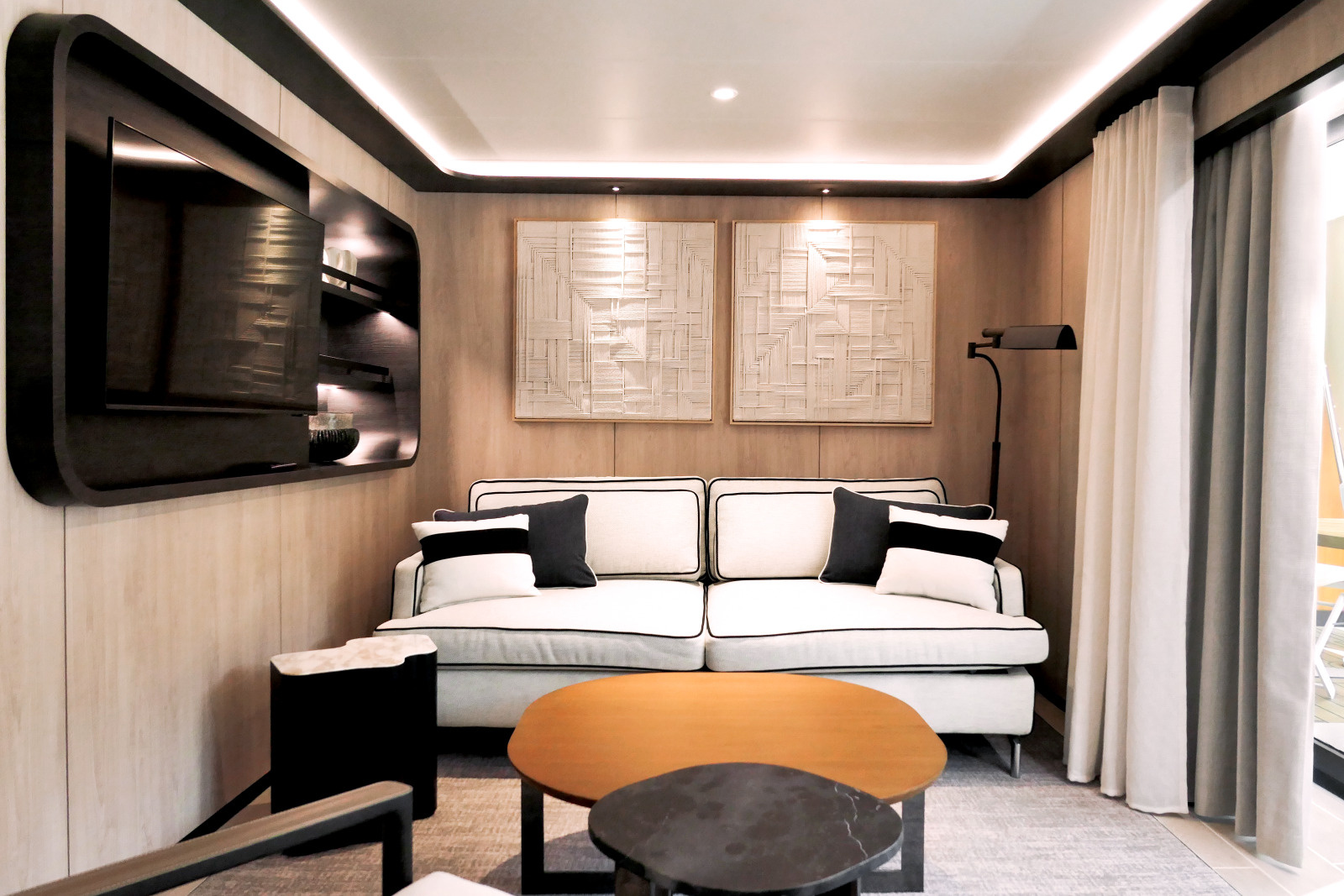
- Individually controlled air conditioning
- Double bed (180 cm x 200 cm) or twin single beds (90 cm x 200 cm), depending on the cabin; adjoining cabins available (for child-friendly cruises)
- Mini bar
- Flat screen TV, satellite channels
- Bose™ Bluetooth Speaker
- Desk with writing supplies
- Electronic safe
- Selection of Dyptique Paris bath products
- Dressing table and hairdryer
- Direct phone line via satellite
- 110/220 volt outlets
- 24-hour room service
- Unlimited free Wi-Fi

- Individually controlled air conditioning
- Double bed (180 cm x 200 cm) or twin single beds (90 cm x 200 cm), depending on the cabin; adjoining cabins available (for child-friendly cruises)
- Mini bar
- Flat screen TV, satellite channels
- Bose™ Bluetooth Speaker
- Desk with writing supplies
- Electronic safe
- Selection of Dyptique Paris bath products
- Dressing table and hairdryer
- Direct phone line via satellite
- 110/220 volt outlets
- 24-hour room service
- Unlimited free Wi-Fi
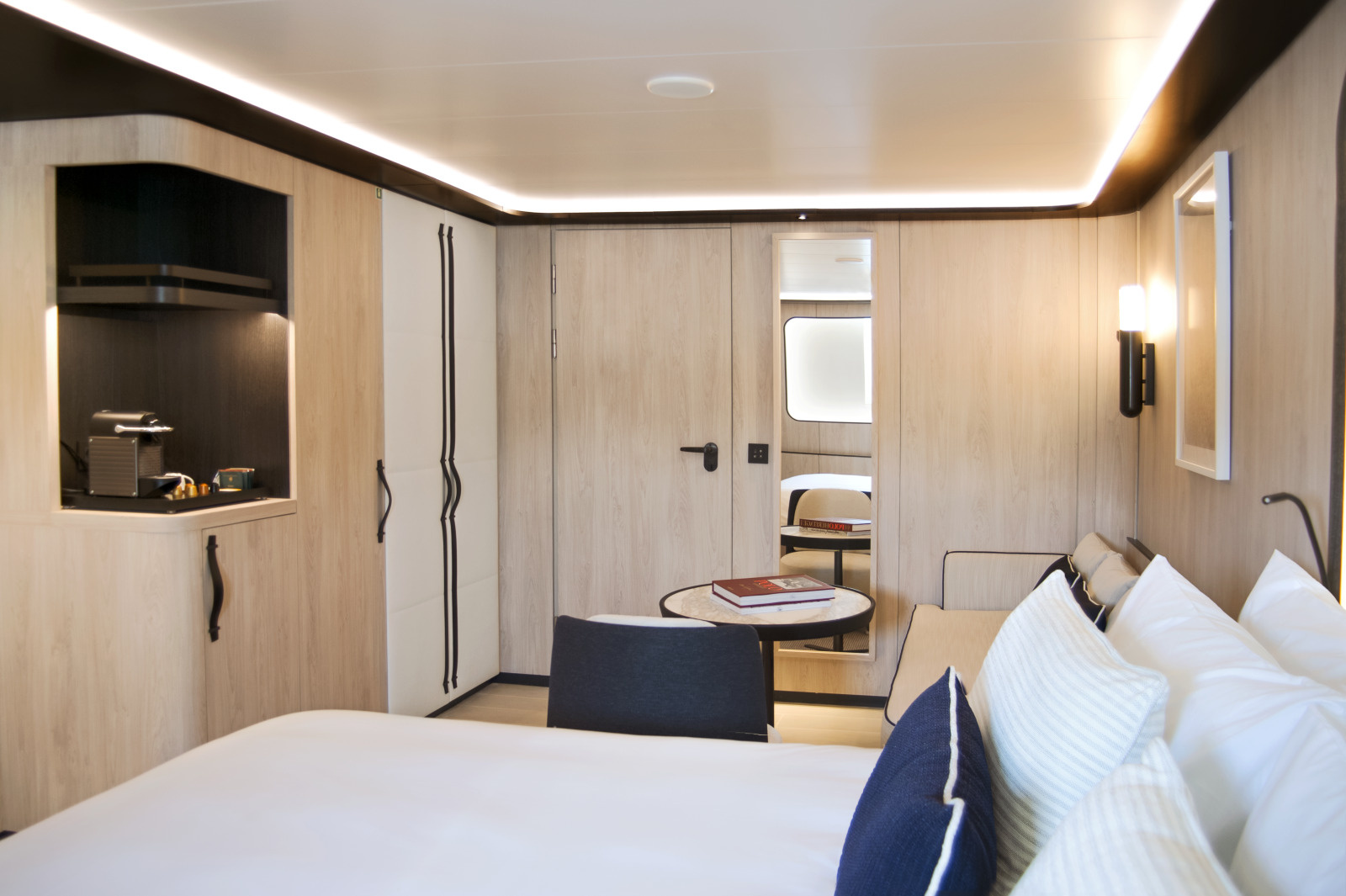
- Individually controlled air conditioning
- Double bed (180 cm x 200 cm) or twin single beds (90 cm x 200 cm), depending on the cabin; adjoining cabins available (for child-friendly cruises)
- Mini bar
- Flat screen TV, satellite channels
- Bose™ Bluetooth Speaker
- Desk with writing supplies
- Electronic safe
- Selection of Dyptique Paris bath products
- Dressing table and hairdryer
- Direct phone line via satellite
- 110/220 volt outlets
- 24-hour room service
- Unlimited free Wi-Fi
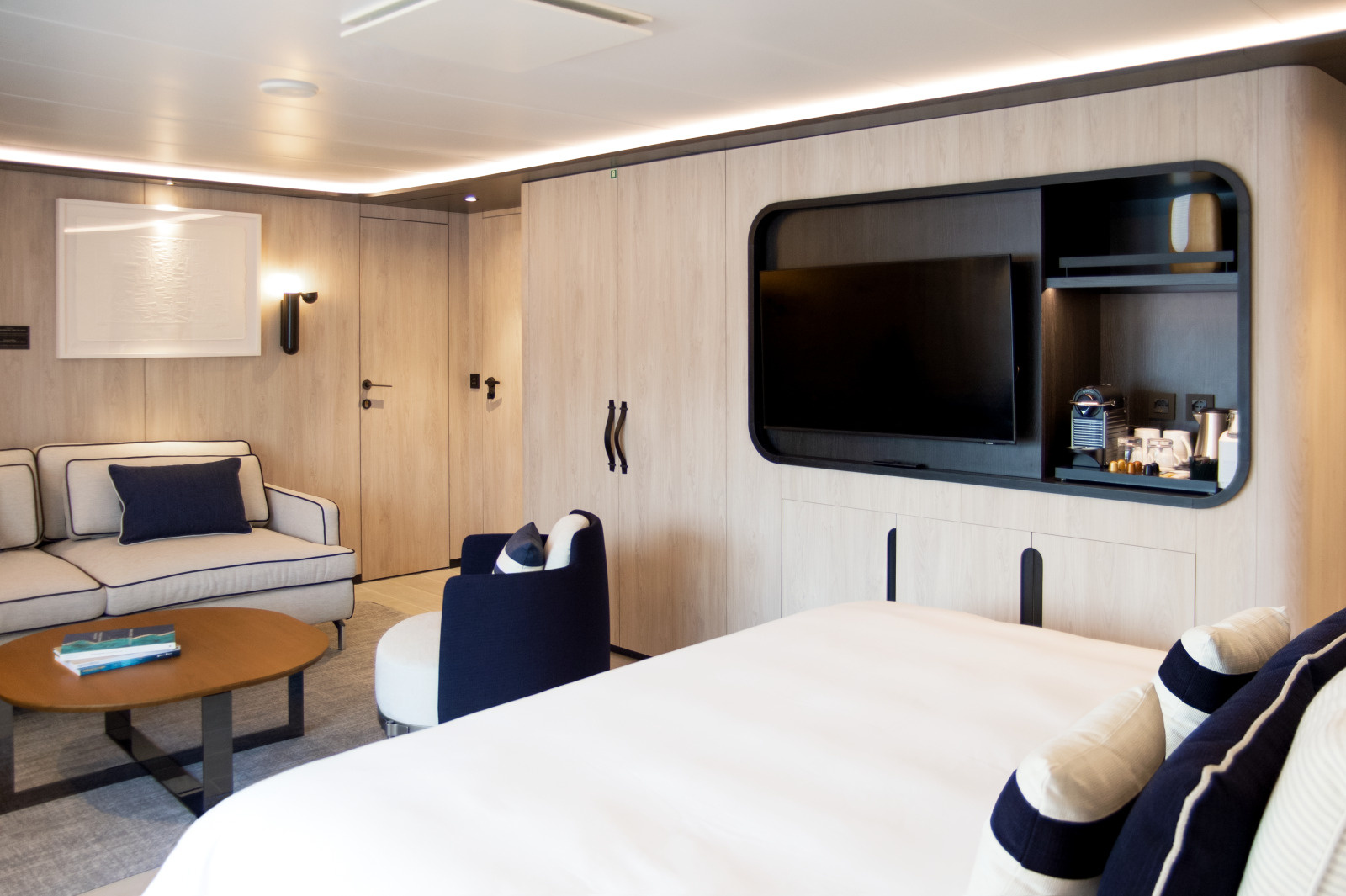
- Individually controlled air conditioning
- Double bed (180 cm x 200 cm) or twin single beds (90 cm x 200 cm), depending on the cabin; adjoining cabins available (for child-friendly cruises)
- Mini bar
- Flat screen TV, satellite channels
- Bose™ Bluetooth Speaker
- Desk with writing supplies
- Electronic safe
- Selection of Dyptique Paris bath products
- Dressing table and hairdryer
- Direct phone line via satellite
- 110/220 volt outlets
- 24-hour room service
- Unlimited free Wi-Fi
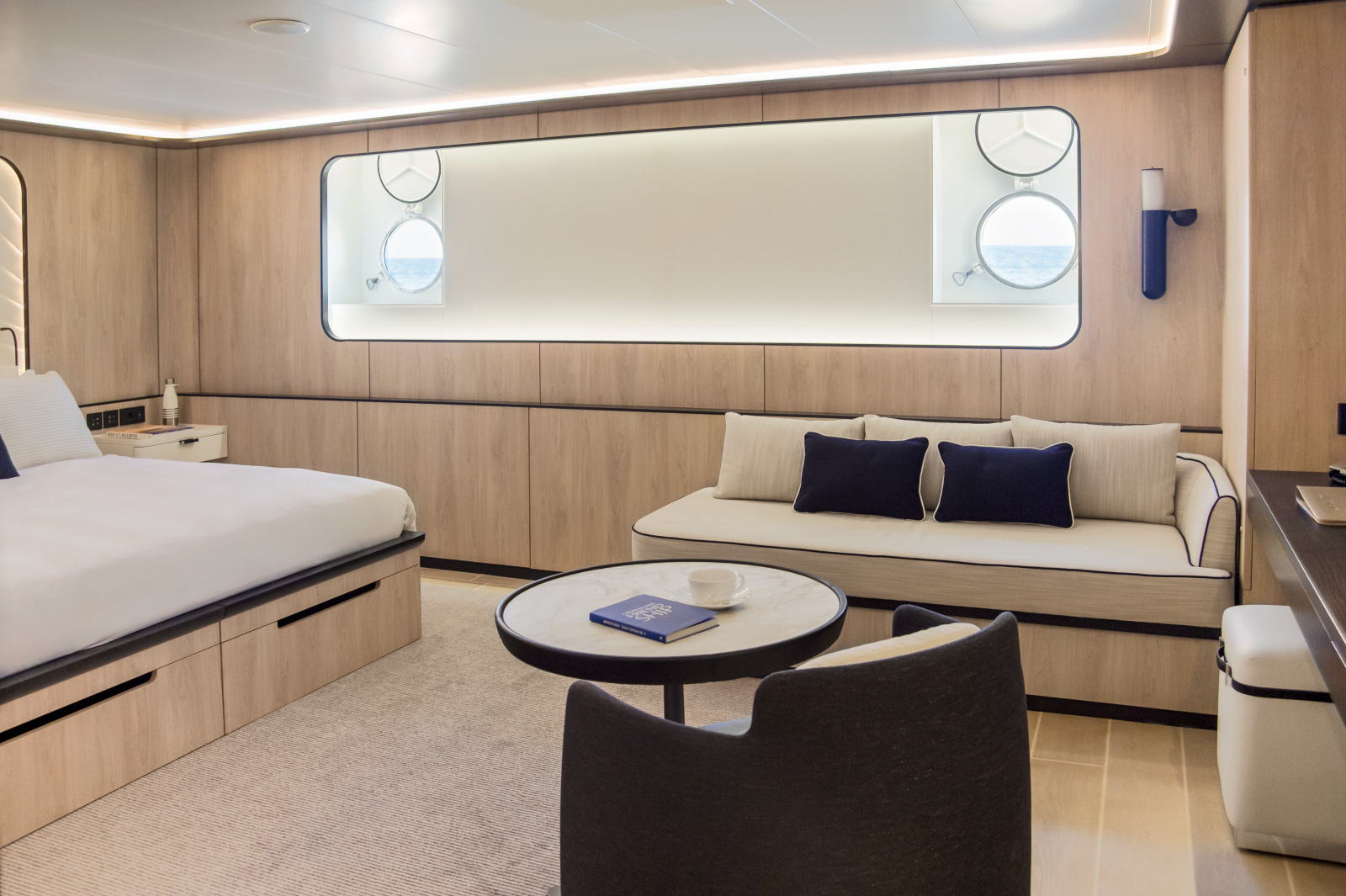
- Individually controlled air conditioning
- Double bed (180 cm x 200 cm) or twin single beds (90 cm x 200 cm), depending on the cabin; adjoining cabins available (for child-friendly cruises)
- Mini bar
- Flat screen TV, satellite channels
- Bose™ Bluetooth Speaker
- Desk with writing supplies
- Electronic safe
- Selection of Dyptique Paris bath products
- Dressing table and hairdryer
- Direct phone line via satellite
- 110/220 volt outlets
- 24-hour room service
- Unlimited free Wi-Fi

- Individually controlled air conditioning
- Double bed (180 cm x 200 cm) or twin single beds (90 cm x 200 cm), depending on the cabin; adjoining cabins available (for child-friendly cruises)
- Mini bar
- Flat screen TV, satellite channels
- Bose™ Bluetooth Speaker
- Desk with writing supplies
- Electronic safe
- Selection of Dyptique Paris bath products
- Dressing table and hairdryer
- Direct phone line via satellite
- 110/220 volt outlets
- 24-hour room service
- Unlimited free Wi-Fi
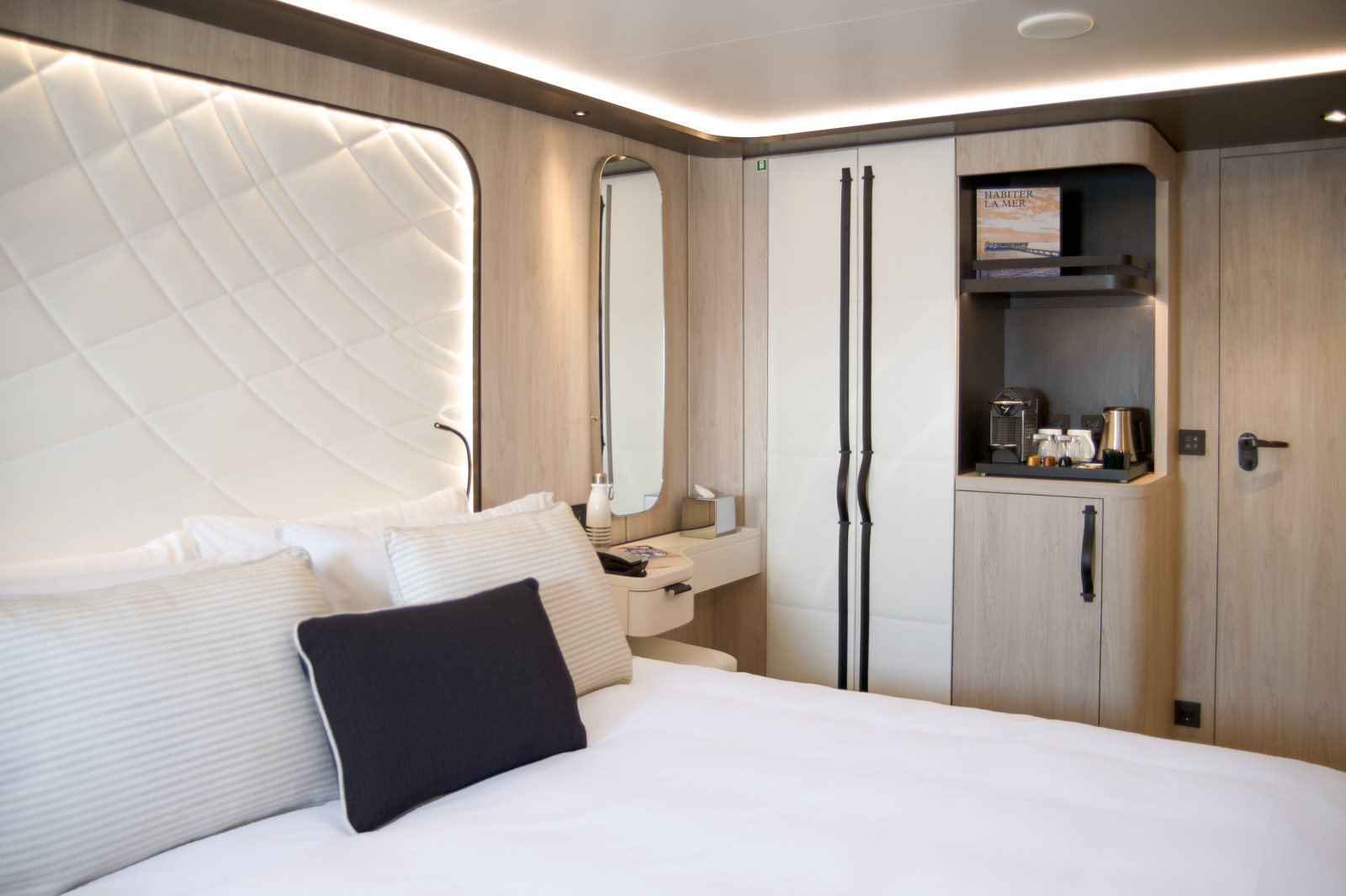
- Individually controlled air conditioning
- Double bed (180 cm x 200 cm) or twin single beds (90 cm x 200 cm), depending on the cabin; adjoining cabins available (for child-friendly cruises)
- Mini bar
- Flat screen TV, satellite channels
- Bose™ Bluetooth Speaker
- Desk with writing supplies
- Electronic safe
- Selection of Dyptique Paris bath products
- Dressing table and hairdryer
- Direct phone line via satellite
- 110/220 volt outlets
- 24-hour room service
- Unlimited free Wi-Fi
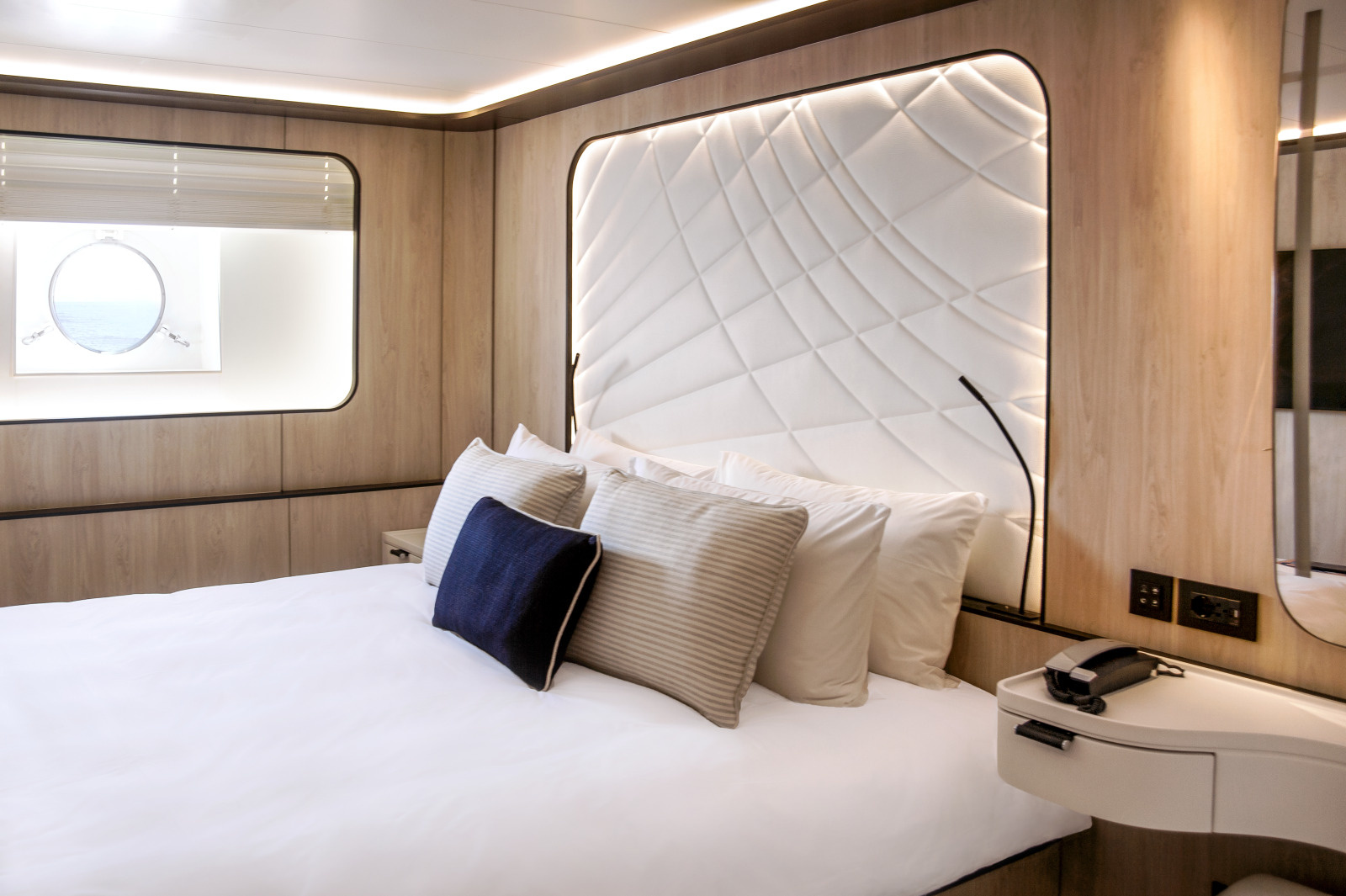
- Individually controlled air conditioning
- Double bed (180 cm x 200 cm) or twin single beds (90 cm x 200 cm), depending on the cabin; adjoining cabins available (for child-friendly cruises)
- Mini bar
- Flat screen TV, satellite channels
- Bose™ Bluetooth Speaker
- Desk with writing supplies
- Electronic safe
- Selection of Dyptique Paris bath products
- Dressing table and hairdryer
- Direct phone line via satellite
- 110/220 volt outlets
- 24-hour room service
- Unlimited free Wi-Fi

- Individually controlled air conditioning
- Double bed (180 cm x 200 cm) or twin single beds (90 cm x 200 cm), depending on the cabin; adjoining cabins available (for child-friendly cruises)
- Mini bar
- Flat screen TV, satellite channels
- Bose™ Bluetooth Speaker
- Desk with writing supplies
- Electronic safe
- Selection of Dyptique Paris bath products
- Dressing table and hairdryer
- Direct phone line via satellite
- 110/220 volt outlets
- 24-hour room service
- Unlimited free Wi-Fi
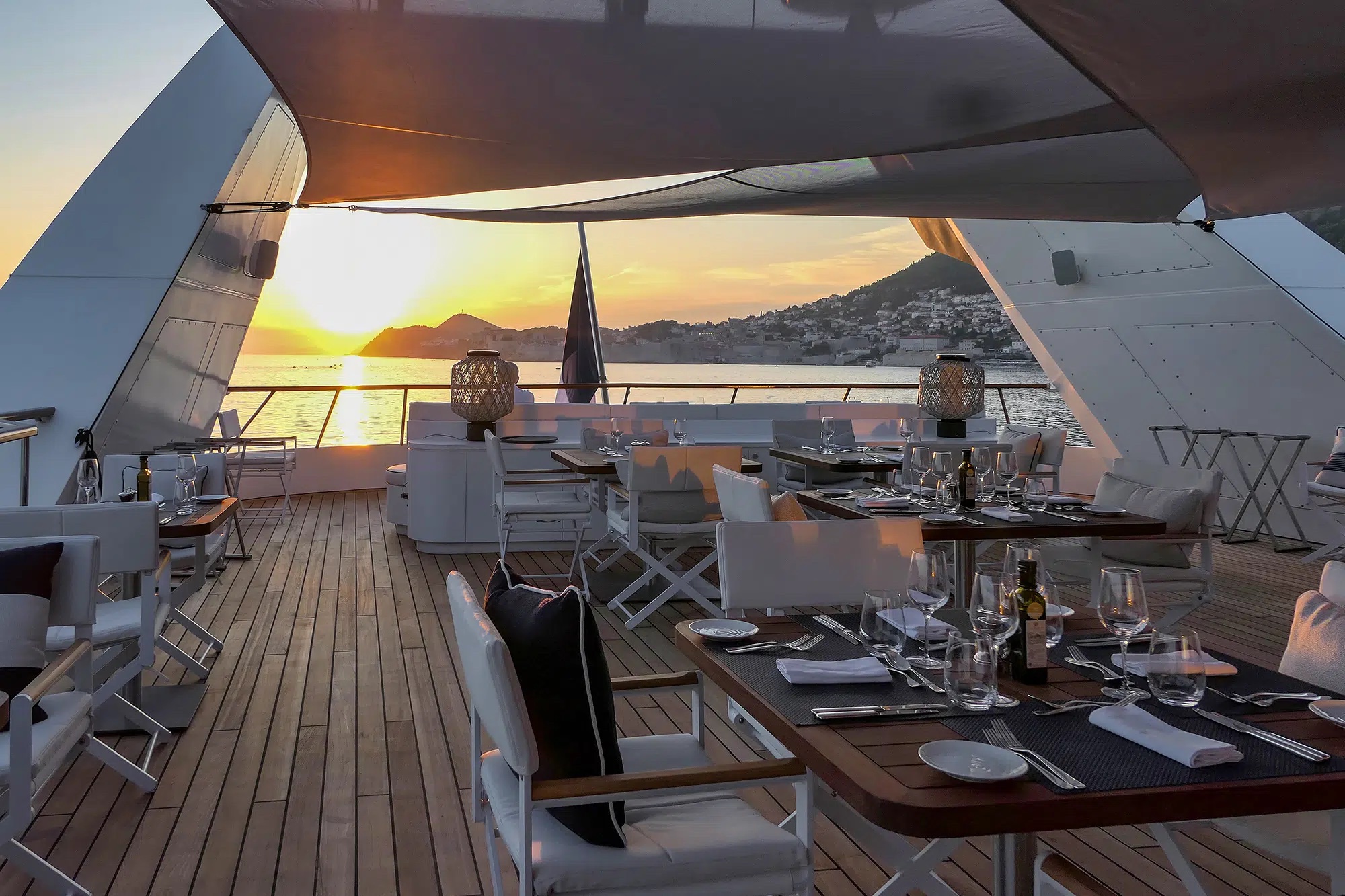
Located on the Zéphyr Deck, Le Diamant Restaurant offers a delicious buffet for breakfast and lunch.
- Seats 34 guests
- 61 m²
- Buffet breakfast and dinner
- Fine gastronomic cuisine made using exceptionally high quality organic and local products
- Veuve Clicquot champagne
- Wines from French artisan wine producers and the regions visited.

Each itinerary has been thoughtfully created by our teams to offer you a complete excursion experience. You can discover the hidden gems of the regions you visit in line with your interests.

- Two glass-bottomed kayaks
- Two stand up paddleboards
- Snorkelling equipment
- Fishing equipment
- Scuba diving equipment (for a group of four people)
- Saltwater swimming pool
- Small equipment for children (noodles, rings, armbands and safety equipment)

- Interior surface : 92 m²
- Seats 35 guests
- Exterior surface : 85 m²
- Seats 24 guests

-
Sun beds
- Exterior bar available on special evenings only

- Spa / massages (18.5 m²): one cabin offering massages and Biologique Recherche treatments
- Gym (16 m²) with dedicated fitness instructor
- Yoga sessions on the Sun Deck
Your stateroom Officer will be able to take care of your laundry**. The washing and ironing of your clothes will take between 24 and 48 hours. Only ironing** can be delivered on the same day. As dry-cleaning is not possible on the ship, please only give us clothes that can be washed in water.
** These services are not free of charge and are billed directly to your stateroom account.
Closed spaces such as the lounges, the dining room, the staterooms and the reception are non-smoking areas. We invite you to smoke in designated outdoor parts of the ship.
Adapters are provided on board, they are available at the reception office of our ships.
European Standard Sockets
The 220 volt 50 hertz alternating current is distributed by sockets meeting European standards. Onboard power is 200 volt AC (European standard) and 110 volt AC (North American standard). For safety reasons, hair irons and clothes irons cannot be used in staterooms. Please note that on Le Ponant, 110 volt AC is only available in stateroom bathrooms.
Children under one year of age shall not be authorised to embark on the ships.
For children aged between 1 and 8 years old, an authorisation to board the ship must be made in writing to PONANT. Subject to agreement, a liability waiver must be completed and returned to the company to validate the registration.
On classic cruises (“yachting”), children are accepted from the age of one, with a maximum of 5 children between 1 and 6 years old on board.
On “expedition” cruises children are accepted from 6 years old (except cruises aboard Le Commandant Charcot) and must be fully independent during all the outside activities organised and during disembarkation in rubber boats, be sufficiently tall to sit on the inflatable sides of the boats, and old enough to understand, and immediately respond to the orders given by the persons in charge. As a result, children’s participation in any activity in an inflatable boat shall be subject to the agreement of the Captain and of the Expedition Head, depending on the sea conditions, and the difficulty of disembarking at each location visited. The ships do not carry Parka’s in children’s sizes. Parents must arrange to bring a suitable Parka for children. In all cases, children and young people under the age of 18 are at all times on board or on land under the full and total responsibility of their parents or carers.
Children aged 4 years or more can be welcomed in the Kid’s Club when the service is offered on board
The crew are bilingual in French and English. All signage and announcements made are in French and English. On certain cruises, crew members also speak other languages.
A satellite telephone system is at your disposal for contacting anyone, anywhere in the world. The cost of the call is added to the stateroom account (€6/minute). Calls that you receive can be transferred directly to your stateroom or to any other communal area on the ship. To receive or send faxes, please see Reception.
Free Wi-Fi internet access is available on all of our ships, in both the staterooms and the communal areas. One or several computers are at your disposal in the recreation centres. Please note that the Wi-Fi connection may be discontinued depending on the navigation area and landscapes that may block the vessel from satellite coverage, especially at high latitudes (no connection possible beyond 80° North or South), or for technical reasons beyond our control.
There is a doctor on board available to the passengers on all our ships:
- The schedules of consultation are listed each day in the log book (emergency consultation 24/7).
- The Sisterships, PONANT Explorers and Le Commandant Charcot also have a hospital for any small surgery.
- During the excursions, the passengers are accompanied by a doctor or a nurse.
- There is a fee for consultations on board . The price may vary according to the time and place of the consultation (hospital or staterooms). You must also pay for medications.
- The doctor on board is not authorised to distribute sick leaves and prescriptions. Only accounts and invoices are provided which may be used by the passenger to obtain a refund from his/her health insurance if his/her contract allows.
Medical Consultations
There is a charge for medical consultations undertaken by the doctor or nurse on board. The price can vary according to the time and place of the consultation (hospital or stateroom). Any medication must also be paid for by the passenger. If using medications on a regular basis make sure to bring adequate supplies for the duration of your cruise.
Special Medical Treatment
If you have any special treatment, we ask you to inform the reservation service when you register for the cruise, to note it on the information sheet before departure, then inform the on-board crew at the moment of departure and always keep your medication with you for the duration of the cruise.
Seasickness
Our ships (except Le Ponant) have stabilisers equipped with dynamic fins which adapt to the movements of the ship. This system allows the ship to anticipate and compensate for the pitching and tossing of the sea to achieve greater stability. Passengers suffering from seasickness will see their symptoms alleviated and are pleasantly surprised to not feel uncomfortable during their journey. However it is wise to bring travel motion medication with you for peace of mind.
Our Sisterships, PONANT EXPLORERS and Le Commandant Charcot were designed for people with reduced mobility in mind:
- Specially designed staterooms;
- Access ramps allowing easy movement in communal areas;
- Posters, signage and stateroom numbers are translated into Braille.
Despite these arrangements, each passenger should be able to be independent or travel with a close family member or friend who can give them whatever assistance they require during their trip.
If a person has not been judged suitably fit for travel in complete safety, the company reserves the right to refuse their embarkation. Disembarkation in difficult places or in a Zodiac® is subject to the approval of the Captain, who will always have the safety and wellbeing of the passenger in mind.
Technical Accessories
We advise you to equip yourself with a ski mask, sunglasses, walking poles (available to purchase in the shop), a waterproof rucksack, binoculars, a technical watch, a mosquito head net (for the Arctic) and a waterproof pouch.
We recommend wearing elegant, casual clothes at your discretion, and for the gala evenings, a cocktail dress for ladies and a shirt and tie for gentlemen, and a white or black-and-white outfit for the Officers’ evening. Shorts/Bermudas are not permitted in the evening in the gastronomic restaurants.
Sustainable development is enshrined in the company’s articles of association and has been at the heart of the PONANT project since its inception. Founded over thirty years ago by committed sailors, the company was born out of a desire to share a passion for the oceans and the treasures of the Earth. This responsibility commits us to a respectful dialogue with the environment and the populations we meet and to investing in many fields related to the preservation and development of the natural and cultural heritage of the polar and oceanic regions.
Clean Ships
We were among the first cruise operators in the world to abandon the use of heavy fuels, and our ships are equipped with electric diesel engines and SCR catalytic converters, which enable a reduction in fuel consumption and emissions. Our polar exploration ship, Le Commandant Charcot, is a hybrid-electric vessel, propelled by liquefied natural gas (LNG). LNG enables a 25% reduction in carbon emissions, an 85% reduction in nitrogen oxide emissions and a 95% reduction in fine particle emissions. Each time we design a new ship, we equip it with the latest available eco-technologies, enabling us to maintain our position as the cruise industry’s environmental leader, ahead of international regulations in some areas. A commitment recognised by many independent organisations:
- Our entire fleet is Clean Ship certified by the Bureau Veritas. This certification guarantees that our ships fulfil very precise criteria: emissions levels, waste processing, waste water etc.
- In 2020, PONANT was recognised as “the cruise operator with the greenest fleet in the world in terms of airborne emissions” by the German NGO, NABU.
- PONANT was awarded the Prix des Palmes du Tourisme Durable 2020 (Prize for Sustainable Tourism) in the “Voyage” category for the elimination of heavy fuel oil in favour of LS MGO.
- In 2019, PONANT became the first European cruise company to obtain the North American Green Alliance certificate. This certifies that its members have adopted practices and technologies that are respectful towards the environment.
- PONANT is also a signatory of the Charte Bleue from Armateurs de France, which commits the maritime sector to act to protect the marine environment.
Wastewater
All of the wastewater is treated by means of processes that exclude the use of chemical products. The recycled water is used to clean the exterior of the ship. The water that is discharged into the sea is treated, drinkable water.
Waste
We have optimised our organisation in order to reduce waste at the source. Waste is nonetheless still produced on board. As of 2020, 60% of this is sorted and recycled, with an objective of 85% set for 2023. We ensure the complete traceability of this waste.
Single-use plastics
We have eliminated the use of single-use plastics (straws, cups, food serving trays, laundry bags etc.). A metallic flask is issued to each passenger on expedition cruises and water fountains are available in the common areas of the ships. We are also developing the bottling of our water in glass bottles.

- Sun Deck
- Jacuzzi
- Bar

- Le Diamant Restaurant
- Suite

- Marina
- Emeraude Lounge
- Reception
- Welcome Lounge
- Spa
- Fitness
- Beauty Area
- Suites/Staterooms

- Medical Centre
- Suites/Staterooms

